In the labyrinthine alleys of Turkish folklore, where myths intertwine with history, and the celestial dances with the earthly, there exists a mysterious and enchanting figure—a half-woman, half-snake entity named Shahmaran/Şahmeran. As confounding as she is captivating, Sahmaran invites us into an age-old tapestry of love, wisdom, and cultural significance. So, who is this elusive queen, and what dark and luminous secrets does she conceal?
Who is Sahmaran?
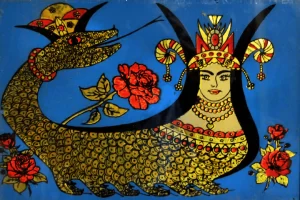
Deep in the realms of Turkish and Mesopotamian mythology, Sahmaran serves as a paradoxical figure—half beautiful woman, half serpent. She lives underground in a hidden world with her snake subjects but periodically graces the human realm. What does Sahmaran mean? Well, the name Sahmaran or originally Şahmeran means “the head of snakes.” It is a combination of ‘Maran,’ which means ‘snake’ in Persian, and ‘Şah,’ a title given to Iranian or Afghan rulers.
The Tale of Sahmaran
The legend is told as follows in anonymous sources says, thousands of years ago in Tarsus, snakes lived seven layers beneath the earth. These snakes, called Merans, lived in peace. The queen of the Merans was Shahmeran, a young and beautiful woman.
According to the legend, the first human to see Şahmeran was Cemşab, the son of a poor family who made a living by selling wood. Cemşab and his friends discovered a cave filled with honey. They lowered Cemşab down to extract the honey, but then they left him there and ran away to get a bigger share of the honey for themselves.
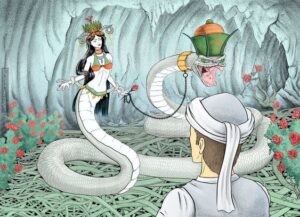
Cemşab noticed light seeping through a hole in the cave. He entered a garden more beautiful than any he had ever seen. The garden had incomparable flowers, a pool, and snakes. Sahmaran sat on a throne at the head of the pool.
Cemşab earned Sahmaran’s trust and lived in this garden for many years. She shared health secrets unknown to medicine with him. Years later, when Cemşab said he missed his family and wanted to leave, Sahmaran allowed him to go but made him promise never to reveal her location.
The First Doctor
Cemşab returned to his family and kept his promise for many years. However, one day, the country’s sultan fell ill. The vizier claimed the cure was to eat Şahmeran’s flesh and spread the news everywhere. When it was realized that Cemşab knew Shahmeran’s location, he had no choice but to disclose it.
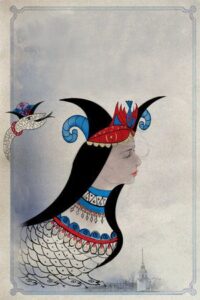
Shahmeran told Cemşab, “Boil my head and give it to the sultan so he can recover. Give my body to the vizier to drink, so he will die. Boil my tail and drink it, and you will become a healer.” And so it happened exactly as Shahmeran had said.
According to the legend, the snakes still do not know to this day that Shahmeran has been killed. It is believed that Tarsus will be invaded by snakes one day when they learn that Shahmeran has been killed.
Symbolism of Wisdom and Duality
Şahmeran embodies the quintessence of wisdom and duality—female and snake, earth and the underground, humanity and the divine. Her serpentine form represents the rebirth, regeneration, and the cyclical nature of life and death. The womanly aspect symbolizes compassion, wisdom, and grace.
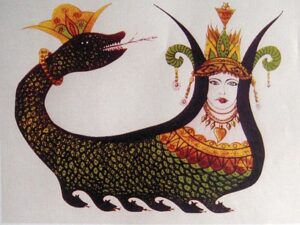
The Turkish queen of snakes is not as a figure to fear for Turkish people, but as an emblem of sagacity, one that people often integrate into their lives. Images of Şahmeran frequently appear in textiles, jewelry, and even in homes, as a protective talisman or a symbol of good luck. Just like Medusa!
Feminine Power and Healing
The legend of Sahmeran brings forth a refreshing narrative where the female figure is neither a damsel in distress nor a malevolent being. Instead, she is a powerful entity whose wisdom and sacrifice bring salvation. This perspective offers a glimpse into the cultural and spiritual landscape where feminine strength, wisdom, and healing are venerated.
The Serpent’s Healing Legacy
It interestingly obvious that the serpent weaves an eternal tale fo medicine. Imagine, if you will, the Şahmaran, with her serpentine body, embodying wisdom and healing. Her story echoing through the ages to the symbol of the caduceus, where twin snakes entwine a staff! A beacon of medical harmony and balance. Snakes’ transformative power is the ultimate symbol of medicine since dawn. From venom to cure, mirroring the dual nature of medicine itself: to harm and to heal. Thus, through whispered tales and etched symbols, the snake remains an enduring emblem of the medical world, a reminder of nature’s potent mysteries and the ancient roots of healing arts.
Cultural Importance and Modern Adaptations
Sahmeran holds a significant cultural status not just in Turkey but also in various parts of the Middle East. She’s a multifaceted figure—changing roles from a storyteller to a healer, from a goddess to a wise queen, depending on where the story is being told.
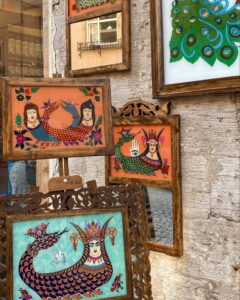
Artists and craftsmen draw inspiration from this enigmatic figure, weaving its likeness into a myriad of art forms such as ceramics, tapestries, jewelry, and murals. The depiction of Sahmaran is not merely an aesthetic choice but a profound manifestation of wisdom, immortality, and the dual nature of humanity and divinity. Through intricate designs and symbolic representation, the snake queen serves as a talismanic presence in homes and sacred spaces, offering protection and guidance.
